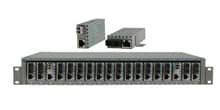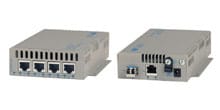- Products
- PoE Media Converters and Switches
- Ethernet & PoE Switches Product Selector
- Multi-Gigabit Ethernet and PoE Switches
- PoE PSE Commercial Switches
- PoE PSE Industrial Fiber Switches
- PoE Industrial Copper Extenders
- PoE Powered Media Converters
- PoE PSE Media Converters
- PoE Extenders & Injectors Product Selector
- Pluggable Transceivers Product Selector
- Product Lines

- iConverter Managed Multi-service Platform
- Copper to Fiber Media Converters
- Ethernet Media Converters
- 10 Gigabit Copper-to-Fiber
- 10/100/1000 Copper to 10 Gigabit Fiber
- 10/100/1000 Copper-to-Fiber with Integrated Management
- 10/100/1000 Industrial Copper-to-Fiber with Integrated Management
- 10/100/1000 Copper-to-Fiber with VLAN
- 10/100/1000 Dual Media Converter with VLAN
- Gigabit Copper-to-Fiber
- 10/100 Copper-to-Fiber with Integrated Management
- 10/100 Industrial Copper-to-Fiber with Integrated Management
- 10/100 Copper-to-Fiber with VLAN
- 10/100 Copper-to-Fiber
- Fast Ethernet Copper-to-Fiber
- Fast Ethernet Redundant Links
- 10Mbps Copper-to-Fiber
- 10Mbps Copper to Coax
- TDM Media Converters
- Serial Media Converters
- Ethernet Media Converters
- Fiber to Fiber Media Converters
- 10 Gigabit Fiber-to-Fiber Converter and Transponder
- 10 Gigabit Industrial Converter and Transponder
- SFP-to-SFP Fiber Converter and Transponder
- SFP-to-SFP Industrial Fiber Converter and Transponder
- Gigabit Fiber to-Fiber with 3 Rs
- 100/1000 Fiber-to-Fiber with 3 Rs
- Gigabit Fiber-to-Fiber
- Fast Ethernet Fiber-to-Fiber with 3 Rs
- Fast Ethernet Fiber-to-Fiber
- OC-3/STM-1 Fiber-to-Fiber
- OC-12/STM-4 Fiber-to-Fiber
- Carrier Ethernet Network Interface Devices
- CE 2.0 - 10G Demarcation NID
- CE 2.0 - 10G Demarcation and Aggregation NID
- CE 2.0 - 10/100/1000 Mult-port NID
- CE 2.0 - 10/100/1000 Mult-port NID with PoE
- CE 2.0 - 10/100/1000 8-Port NID
- SFP NID - Gigabit SFP NID
- microNID - 100/1000 compact NID
- CE 1.0 Service OAM - 10/100/1000 NID
- CE 1.0 Link OAM - 10/100/1000 Copper-to-Fiber NID
- CE 1.0 Link OAM - 10/100 Copper-to-Fiber NID
- CE 1.0 Link OAM - Gigabit Fiber-to-Fiber NID
- CE 1.0 Link OAM - Fast Ethernet Fiber-to-Fiber NID
- CWDM Multiplexers
- T1/E1 Multiplexers
- Ethernet Switch Modules
- Management System
- Chassis Options

- 1-Module Industrial Chassis

- RuggedNet Industrial Switches and Extenders
- Industrial PoE PSE Fiber Switches
- Multi-Gigabit Managed Industrial PoE+/BT Switches
- Multi-Gigabit Unmanaged Industrial PoE+/BT Switches
- 10G Managed 802.3bt PoE Switches
- 10G Unmanaged 802.3bt PoE Switches
- 10G Managed PoE+ Switches
- 10G Unmanaged PoE+ Switches
- 1G Managed PoE+ Switches
- 1G Unmanaged PoE+ Switches
- 1G Unmanaged 802.3bt PoE Switches
- 1G Managed 802.3bt PoE Switches
- Industrial Ethernet Switches
- Industrial PoE Copper Extenders
- Industrial Power Supplies

- OmniConverter Media Converter, Switches and Extenders
- PoE PSE Media Converters
- 10G Multi-Gigabit / Multi-Rate PoE Media Converter
- 10G Multi-Gigabit / Multi-Rate Media Converter
- 10/100 Multi-port PoE+ Media Converter
- 10/100 PoE+ Media Converter
- 10/100/1000 Multi-Port PoE+ Media Converter
- Industrial 10/100/1000 Multi-Port PoE+ Media Converter
- 10/100/1000 PoE+ Media Converter
- 10/100/1000 PoE++ 60W-100W Media Converter
- Industrial 10/100 Multi-port PoE+ Media Converter
- 1U Rack-Mount Shelf
- PoE PSE Compact Switches
- Multi-Gigabit Managed PoE+/BT Switches
- Multi-Gigabit Unmanaged PoE+/BT Switches
- 10G Managed 802.3bt PoE Switches
- 10G Unmanaged 802.3bt PoE Switches
- 10G Managed PoE+ Switches
- 10G Unmanaged PoE+ Switches
- 1G Managed PoE+ Switches
- 1G Unmanaged PoE+ Switches
- 1G Managed 802.3bt PoE Switches
- 1G Unmanaged 802.3bt PoE Switches
- Ethernet Switches
- PoE Copper Extenders
- Single Pair Ethernet Converters
- PoE Injectors

- miConverter Unmanaged Miniature Media Converters
- 10/100/1000 Copper-to-Fiber
- Industrial 10/100/1000 Copper-to-Fiber
- 10/100/1000 Ultra-Compact Copper-to-Fiber
- Gigabit Copper-to-Fiber
- 10/100/1000 Copper-to-Fiber PoE Powered
- 10/100 Copper-to-Fiber
- 10/100 Ultra-Compact Copper-to-Fiber
- 10/100 Copper-to-Fiber PoE Powered
- 18-Module Chassis
- Industrial 10/100 Copper-to-Fiber PoE Powered

- FlexSwitch Compact Switches
- Solutions
- Company
- Support
- How to Buy
Building a Disaster Recovery Plan for Your Industrial Network

Industrial networks are the backbone of operational efficiency and productivity in today's interconnected world. However, with this increased dependency comes a significant risk—what happens when disaster strikes? Whether it's a cyberattack, a system failure, or a natural disaster, minimizing downtime and maintaining business continuity require a strong disaster recovery plan (DRP).
What is a Disaster Recovery Plan?
A recorded, systematic method with guidelines for handling unforeseen events is called a disaster recovery plan. It is a critical component of an overall business continuity strategy. Precautions are taken as part of the strategy to lessen the impact of a disaster and enable the company to promptly or continue mission-critical operations.
Why is a Disaster Recovery Plan Important?
A disaster recovery plan is not just a nice-to-have; it's a necessity. Industrial networks are susceptible to various threats that can cause catastrophic disruptions. These disruptions can lead to reputational damage, massive financial losses, and, in some cases, regulatory penalties. Having a well-structured DRP ensures that your network can quickly recover from any disaster, safeguarding your business operations.
Steps to Build an Effective Disaster Recovery Plan
A successful disaster recovery strategy entails a number of crucial actions that ensure your industrial network can endure and bounce back quickly from any disaster.
Conduct a Risk Assessment
Identify potential threats to your industrial network. These can include natural disasters, cyber-attacks, equipment failures, and human error. To determine which hazards to prioritize for your planning, evaluate their impact and likelihood.
Perform a Business Impact Analysis (BIA)
Determine the potential impact of different disaster scenarios on your operations. This analysis will help you identify critical systems and processes that need to be prioritized in your recovery plan.
Develop Recovery Strategies
Outline the strategies for recovering your network and systems. These may include data backups, alternative communication channels, and emergency response procedures.
Create the Plan
Document the step-by-step procedures for disaster response and recovery. Ensure the plan is detailed and easy to understand, covering everything from initial response to full restoration of services.
Test the Plan
Test your disaster recovery plan frequently using simulations and drills. This will help you identify any weaknesses in the plan and ensure that all personnel know their roles and responsibilities.
Maintain and Update the Plan
Planning for disaster recovery is a continuous process. Review and revise your plan frequently to take into consideration emerging risks, technological advancements, and insights gained from simulations and real-world events.
Critical Elements of a Disaster Recovery Plan
Several critical elements must be included in your disaster recovery plan to ensure comprehensive coverage and effectiveness.
Data Backup and Recovery
Having reliable data backup solutions is crucial. Ensure that all critical data is backed up regularly and that backups are stored in multiple locations.
Communication Plan
Create a detailed communication strategy to alert all parties involved in a disaster. This includes employees, customers, suppliers, and emergency services.
Incident Response Team
Assign the task of carrying out the catastrophe recovery plan to a specialized incident response team. This group needs to be prepared for a range of emergency situations with proper training and equipment.
Emergency Response Procedures
Describe the steps that should be taken right away in case of an emergency. This includes evacuation procedures, safety protocols, and initial damage assessment.
Network Redundancy
Implement network redundancy to ensure that there is no single point of failure. This can involve redundant servers, multiple internet connections, and failover systems.
Vendor and Supplier Management
Ensure that your vendors and suppliers also have robust disaster recovery plans. Their failure can impact your recovery efforts.
Regulatory Compliance
Make sure that your disaster recovery plan complies with industry regulations and standards. Penalties and legal problems may result from non-compliance.
Best Practices for Disaster Recovery Planning
Following best practices can enhance the effectiveness and reliability of your disaster recovery plan.
Involve All Stakeholders
Include input from all departments and stakeholders in the planning process. This ensures that all aspects of the business are considered.
Keep It Simple
While your plan needs to be comprehensive, it should also be simple enough for everyone to understand and execute under stress.
Regular Training
Make sure all employees receive frequent training so they are familiar with the disaster recovery procedures.
Leverage Technology
Use advanced technologies like cloud computing and automation to enhance your disaster recovery capabilities.
Continuous Improvement
Disaster recovery planning is an ongoing process. Continuously look for ways to improve your plan based on feedback and new developments.
The Role of Technology in Disaster Recovery
Technology plays a vital role in modern disaster recovery planning and implementation.
Cloud Solutions
Cloud-based disaster recovery solutions offer scalability, flexibility, and cost-effectiveness. They enable rapid recovery of data and applications, minimizing downtime.
Automation
Automation tools can help streamline the recovery process, reducing the chances of human error and speeding up the restoration of services.
Cybersecurity Measures
Implement strong cybersecurity measures to protect your network from cyber threats. This includes firewalls, intrusion detection systems, and regular security audits.
Remote Monitoring and Management
Make use of remote management and monitoring tools to monitor your network's health and quickly address any issues that arise.
Common Pitfalls to Avoid
Avoiding common pitfalls can significantly improve the success of your disaster recovery plan.
Lack of Testing
A plan that is not tested is a plan that is likely to fail. To ensure that your disaster recovery strategy functions as intended, regular testing is essential.
Ignoring Small Details
Sometimes, it's the small details that can cause the biggest problems. Make sure every aspect of your network and operations is covered.
Overlooking Human Factors
Human error is a common cause of disasters. Ensure that all employees are well-trained and understand their roles in the disaster recovery plan.
Inadequate Documentation
Ensure that all procedures and steps are thoroughly documented. Ambiguities can lead to confusion and delays during a crisis.
Case Studies: Successful Disaster Recovery in Industrial Networks
Real-world examples highlight the importance and effectiveness of well-executed disaster recovery plans.
Case Study 1: Manufacturing Plant Resilience
A manufacturing plant faced a severe flood that damaged critical infrastructure. Thanks to their comprehensive disaster recovery plan, they were able to restore operations within 48 hours, minimizing financial losses and maintaining customer trust.
Case Study 2: Cyber Attack Mitigation
An industrial network was targeted by a sophisticated cyber-attack. Their effective incident response plan and strong cybersecurity safeguards enabled them to quickly isolate the compromised systems and resume regular operations with little to no data loss.
FAQs
What is the first step in creating a disaster recovery plan?
Doing a risk assessment is the first step in determining possible dangers to your industrial network. This involves evaluating various risks, such as natural disasters, cyber-attacks, and equipment failures. Understanding these risks helps prioritize and tailor the recovery plan to address the most critical threats.
How often is it appropriate to test a disaster recovery plan?
A disaster recovery plan should be tested at least annually to ensure its effectiveness. Additionally, it should be tested whenever there are significant changes to the network, operations, or technology. Regular testing helps identify weaknesses and continuously improve the plan.
What are the key components of a disaster recovery plan?
Key components include risk assessment, business impact analysis, recovery strategies, plan development, testing, and maintenance. Every element is essential to guaranteeing a thorough and successful healing strategy. Together, they help minimize downtime and ensure business continuity.
Why is network redundancy important in disaster recovery?
Network redundancy ensures there is no single point of failure in your network. This means that if one part of the network fails, other parts can take over, allowing operations to continue. It enhances the reliability and resilience of your network during a disaster.
How can cloud solutions benefit disaster recovery efforts?
Cloud solutions offer scalability, flexibility, and rapid data recovery, making them a cost-effective and efficient option for disaster recovery. They allow for quick restoration of data and applications, minimizing downtime. Additionally, cloud services often include advanced security features to protect against cyber threats.
Omnitron's Role in Disaster Recovery
Building a disaster recovery plan for your industrial network is a complex but essential task. Omnitron Systems offers a range of solutions to support your disaster recovery efforts:
Redundant Network Components: Our industrial-grade switches feature redundant power supplies and other redundancy features to minimize downtime.
- Network Monitoring: Our network management tools provide real-time visibility into network health, allowing for early detection of potential issues.
- Cybersecurity Solutions: Our security features help protect your network from cyberattacks, reducing the risk of data loss and disruption.
By partnering with Omnitron, you can build a robust disaster recovery plan that protects your industrial network and ensures business continuity.
Contact Omnitron Systems Today!









